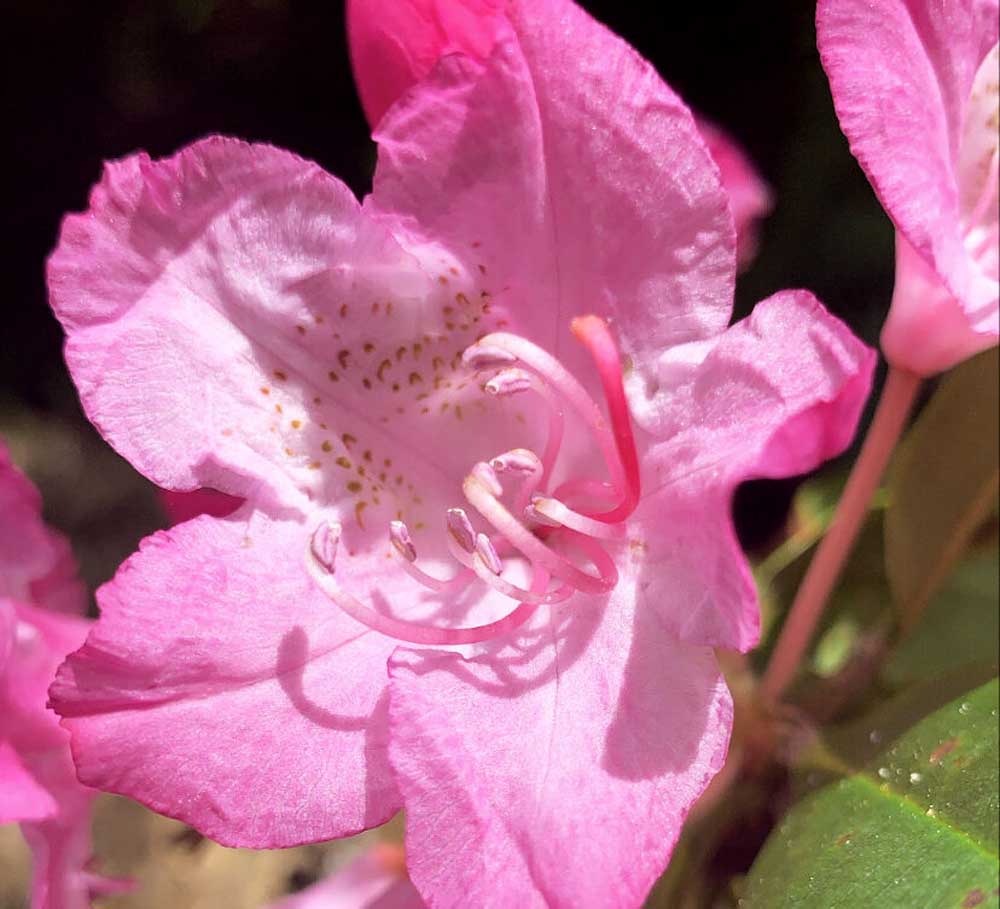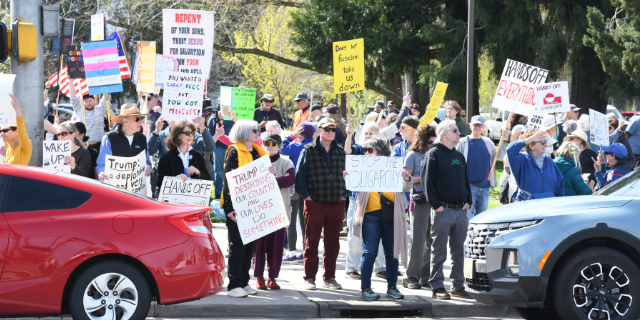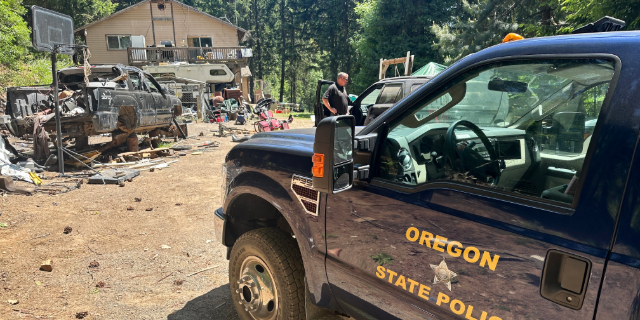GARDEN PLOTS: Understory trees, shrubs, and groundcovers for a wonder-full woodland garden
Published 7:00 am Sunday, February 12, 2023

- Native flowering trees and shrubs like this Pacific rhododendron will be combined with non-natives for diverse color and a long blooming season in the author’s woodland garden.
“In making a garden, we need to combine our limited understanding of what occurs in nature with our desire to show plants to their best advantage, and to create pleasing pictures for as much of the year as possible.”
— Beth Chatto in “Woodland Garden: Shade-loving Plants for Year-Round Interest,” 2002
Award-winning landscape designer, plantswoman, and author Beth Chatto admitted in her best-known book, “Woodland Garden,” that she and her husband, Andrew, were not always on the same page when it came to choosing plants for the Wood Garden at their farm in Essex. Andrew preferred using native plants that blended naturally with the rural landscape in east England, whereas Beth thought it was important to combine native and non-native plants in order to create a more powerful visual effect.
“I would not limit my choice of plants to English natives, since I felt the area was too small and my lifespan too short,” Chatto wrote. Instead, her plant list included predominately species plants from countries with temperate climes all over the world.
“Neither would I try to keep any country’s associations together, but would combine, for example, American and Japanese shade-loving plants if they would set one another off, or would prolong the season of interest. I would try to avoid anything that would look incongruous in this setting, or which needed plentiful rainfall,” she noted.
I have decided to take Chatto’s philosophy to heart when selecting plants for my own woodland garden in Bandon. I plan to use mostly Oregon natives that are commonly found in mixed conifer and broadleaf forests in the area; however, I want to combine the native plants with non-native species and hybrids within the same genera or family to add more variety.
For example, one of the typical native understory trees in the area is the Pacific rhododendron (R. macrophyllum). We have two of these rhodies, which I love for their evergreen leaves and pretty pink flowers in June that help sustain native bees and other beneficial insects. To these I want to add non-native rhododendrons that will provide complementary colors and a prolonged bloom season.
Chatto recommended R. ‘Sappho’, another evergreen rhododendron that has mauve-white flowers and an interesting dark-purple blotch; however, a newer, similarly colored hybrid called R. ‘Calsap’ is supposed to be hardier and have better plant form, meaning less pruning will be needed to maintain its shape.
Recently, I wrote about preparing our woodland garden by thinning out trees and huckleberry shrubs, and creating a winding path through the trees and island planting beds. Our next task is to plant understory trees and shrubs and a mix of vigorous groundcovers. Along with the canopy trees, these plants will form the core of the woodland garden to which I can add over time.
To narrow down my plant selections, I needed to keep in mind our growing conditions in Bandon: wet, windy winters, dry summers, acidic, sandy soil, and dappled sunlight in the woods throughout the day.
It was also helpful to inventory the native understory plants that are already thriving there. Besides Pacific rhododendron and evergreen huckleberry (Vaccinium ovatum), extant understory trees/shrubs include: trailing blackberry (Rubus ursinus), vine maple (Acer circinatum), oceanspray (Holodiscus discolor), California wax myrtle (Myrica californica), Oregon grape (Berberis aquifolium), thimbleberry (Rubus parviflorus), salal (Gaultheria shallon) and Western sword fern (Polystichum munitum).
With a foundational inventory of natives, I could identify compatible native and non-native trees/shrubs, and groundcover plants that will form a visually pleasing and diverse woodland community.
Trees, shrubs, climbers: native paired with non-native plants
- Western dogwood (Cornus nuttallii) with variegated dogwood (C. sericea ssp. sericea ‘Elegantissima’)
- Redtwig dogwood (C. sericea ssp. sericea) with bloodtwig dogwood (C. sanguinea ‘Midwinter Fire’)
- Vine maple (Acer circinatum) with dwarf Japanese maple (A. palmatum)
- Western serviceberry (Amelanchier alnifolia ‘Regent) with serviceberry (A. lamarckii)
- Dwarf Oregon grape (Berberis nervosa) with grape holly (B. x hortensis ‘Winter Sun’)
- Flowering currant (Ribes sanguineum; R. sanguineum ‘White Icicle’) with winter flowering currant (R. laurifolium)
- Western spirea (Spirea douglasii) with Japanese spirea (S. japonica ‘Anthony Waterer’ and ‘Goldflame’)
- Salmonberry (Rubus spectabilis) and Thimbleberry (R. parviflorus) with flowering raspberry (R. odoratus) and white-stemmed bramble (R. cockburnianus ‘Goldenvale’)
- Mock orange (Philadelphus lewisii ‘Goose Creek’) with snowdwarf mock orange (P. ‘Snowdwarf’) and climbing hydrangea (H. anomala var. petiolaris)
- Snowbrush (Ceanothus velutinous) with Japanese skimmia (Skimmia japonica) – These shrubs are unrelated but have similar shiny, evergreen leaves.
- Western sword (Polystichum munitum) with maidenhair fern (Adiantum raddianum) and autumn fern (Dryopteris erythrosora)
- Sweetbriar rose (Rosa eglanteria) with R. ‘New Dawn’, R. ‘Ballerina, and R. ‘Paul’s Himalayan Musk’
- Western trumpet honeysuckle (Lonicera ciliosa) with Japanese honeysuckle (L. japonica)
- Western white clematis (Clematis ligusticfolia) with C. ‘Nelly Moser’ and C. montana ‘Elizabeth’
Groundcovers: native paired with non-native plants
- Bunchberry (Cornus canadensis) with woodland phlox (P. divaricata)
- Wild ginger (Asarum canadense) with foamflower (Tiarella cordifolia)
- Salal (Gaultheria shallon) with false Solomon’s seal (Maianthemum racemosum)
- Trailing blackberry (Rubus ursinus) with woodland strawberry (Fragaria vesca)
- Fringecup (Tellima grandiflora) with barrenwort (Epimedium x versicolor ‘Sulphureum’)
The OSU Extension provides a helpful list of native and non-native landscape plants at https://landscapeplants.oregonstate.edu/. Search for plants by Latin or common names; results will provide a description of the plant, etymology of the Latin name and an explanation of cultivar names, cultural requirements, hardiness zones, and helpful pictures of the plants at different times of the year. A listing of plant species in the same genus is provided on the right side of the page.
Check back next week when I will share my planting plan and Chatto’s recommendations for herbaceous perennials in the woodland garden.
I have decided to take author Beth Chatto’s philosophy to heart when selecting plants for my own woodland garden in Bandon. I plan to use mostly Oregon natives that are commonly found in mixed conifer and broadleaf forests in the area; however, I want to combine the native plants with non-native species and hybrids within the same genera or family to add more variety.






